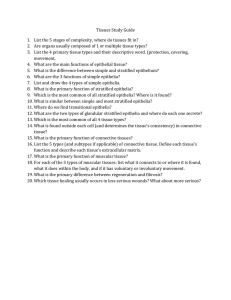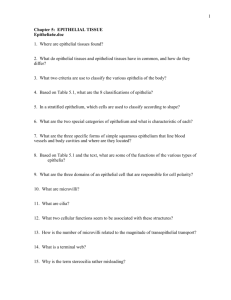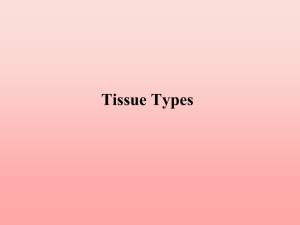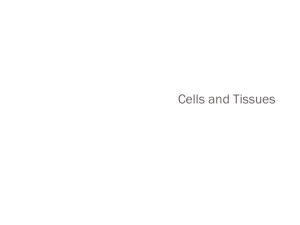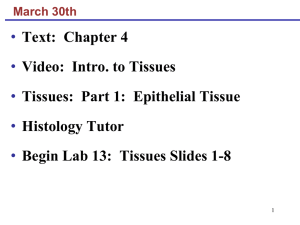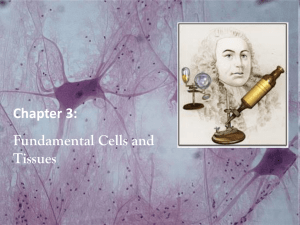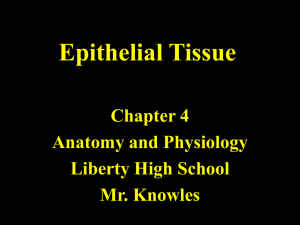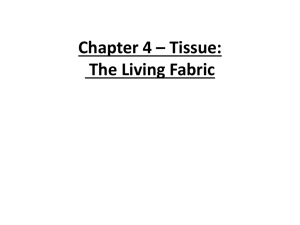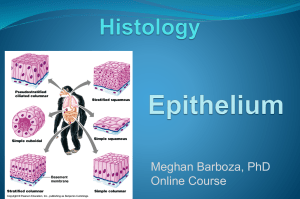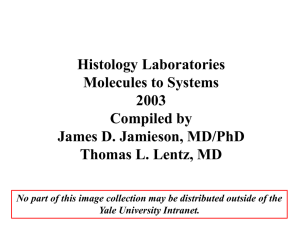Tissues
advertisement
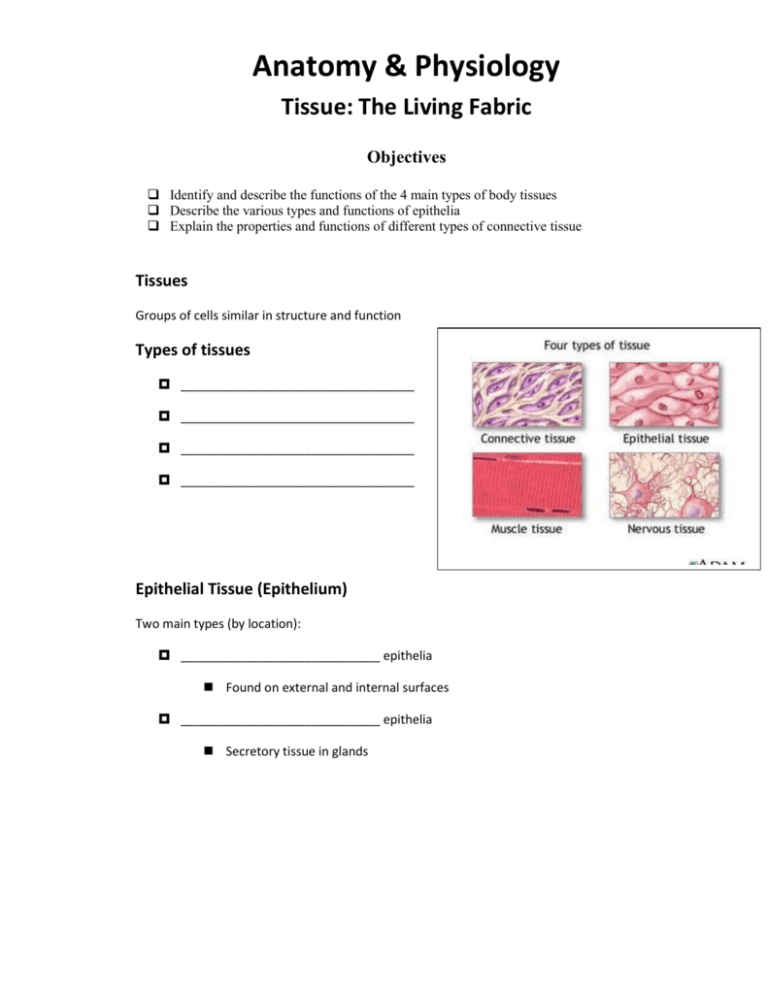
Anatomy & Physiology Tissue: The Living Fabric Objectives Identify and describe the functions of the 4 main types of body tissues Describe the various types and functions of epithelia Explain the properties and functions of different types of connective tissue Tissues Groups of cells similar in structure and function Types of tissues __________________________________ __________________________________ __________________________________ __________________________________ Epithelial Tissue (Epithelium) Two main types (by location): _____________________________ epithelia Found on external and internal surfaces _____________________________ epithelia Secretory tissue in glands Functions of Epithelial Tissue 6 main functions of epithelium __________________________________ (skin) __________________________________ (digestive tract, kidneys) __________________________________(digestive tract, kidneys) __________________________________(digestive tract, kidneys) __________________________________(glands, kidneys) __________________________________ (skin) Homeostatic Imbalance of Epithelium An important characteristic of cancerous epithelial cells is their failure to respect the basement membrane boundary. (85 out of 100 cancers are of epithelial cells) They penetrate it and invade the tissues beneath. Characteristics of Epithelial Tissue 1. Cells have _______________________- apical (upper, free) and basal (lower, attached) surfaces -cell regions near the apical surface differ in structure and function from cell regions in the basal surface. Apical surfaces may have: _________________________: finger-like extensions of the plasma membrane that increase surface area. Lining of the ___________________________ __________________________: tiny hair like projections that propel substances along their free surface. Lining of the ________________________________ 2. Are composed of closely packed cells to form continuous ______________________________. 3. Supported by a connective tissue _____________________________________ (under the basal lamina) A layer of extracellular material containing a network of collagen and protein fibers. 4. _______________________________ (contains no blood vessels) but ___________________________ (supplied by nerve fibers). Epithelial cells are nourished by substances diffusing from blood vessels in the underlying connective tissue. 5. High rate of ____________________________________ Reproduce rapidly to replace lost cells due to hostile substances in the external environment. Classification of Epithelia Ask two questions: 1. How many layers? 1 layer = _________________________ epithelium Very thin most concerned with absorption, secretion, and filtration. 2 or more layers = _________________________________ epithelium More durable, major role is protection. 2. What type of cell? Squamous _________________________________________ Flattened and scale-like _________________________________________ Cuboidal Box-like, tall as they are wide __________________________________________ Tall and column shaped (If stratified, name according to apical (top) layer of cells) Columnar (b) Classification based on cell shape. Epithelia: Simple Squamous Thin, often permeable cells Found where filtration and exchange of substances by rapid diffusion is a priority _________________________________ _________________________________ _________________________________ Two noteworthy names! 2. ______________________________________: “innercovering” slick-friction reducing lining The lining of lymphatic vessels, blood vessels, and heart 3. ______________________________________: “middlecovering” The epithelium of serous membranes in the ventral body cavity Epithelia: Simple Cuboidal Important function of this epithelium is ___________________________ and _______________________ Forms the walls of the smallest ducts of ______________ and of many __________________ tubules Epithelia: Simple Columnar Single layer of tall, closely packed cells Some have ____________________ Functions are _________________________, secretion of _________________, ___________________, and other substances Ciliated type probels _____________________ Location: Non-ciliated lines most of the _____________________________, gall bladder, and excretory ducts of some glands Ciliated types line small _______________, Uterine tubes and some regions of the ______________________. Epithelia: Pseudostratified Columnar Epithelia Single layer of cells of differing ________________________, some not reaching the free surface ____________________ seen at different levels May contain _____________________________cells and have ______________________ Function: Secretion, particularily of _______________________ Propulsion of mucus by _______________________ Location: Non-ciliated type in male’s sperm-carrying ducts and ducts of large glands Ciliated types line the ___________________ and most of the ____________________ respiratory tract. Epithelia: Stratified Squamous Thick membrane compost of many layers Basal cells are ______________________ or _________________________ Surface cells are flattened (squamous) o Keritinized type: surface cells are full keratin and ___________________ o Basal cells are active in _____________________ and produce the cells of more _________________________ layers Function: Protects underlying tissues in areas subjected to ____________________________ Location: Nonkeritinized type forms the moist linings of the __________________________, _______________, and __________________________ Keritinized type forms the _________________________ of the _______________ Epithelia: Stratified Cuboidal Quite rare in body Found in some ___________________and __________________________ glands Typically only _________ cell layers thick Epithelia: Stratified Columnar Limited distribution in body Small amounts in ________________________, male urethra, and lining some glandular ducts Also occurs at transition areas between two other types of epithelia Epithelia: Transitional Resembles both stratified ____________________________ and stratified ________________________ Basal cells cuboidal or columnar Surface cells __________________ shaped or _________________________ dependon on organ stretch Function: Stretches readily and permits distension of urinary organ by urine Location: Lines the _________________, ___________________________________ and part of the urethra
